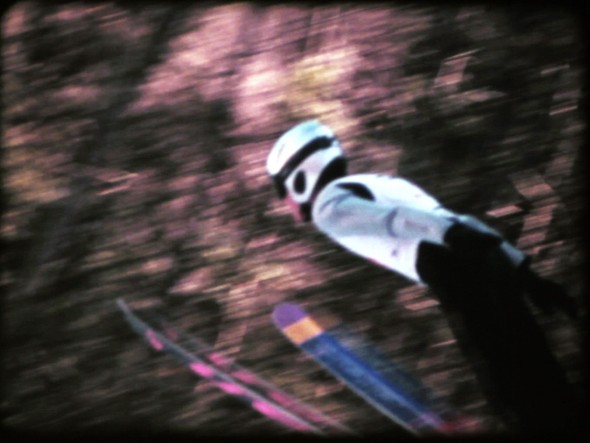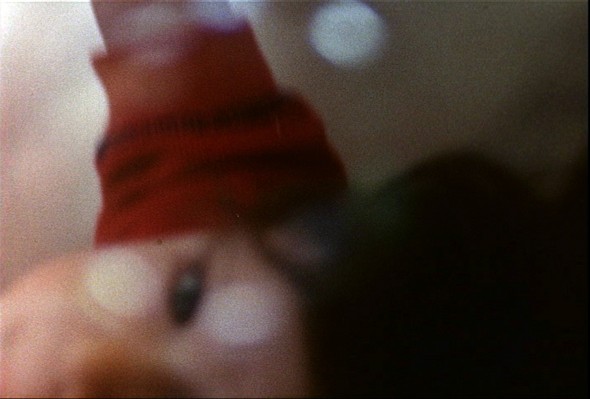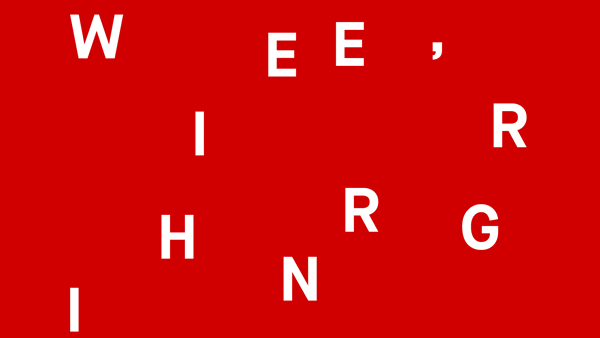Presence and loss permeate the public imagery that Jonathan Schwartz recreates and confronts in a very private way. His camera writes like a pencil with an attached eraser that wipes out its own trace, especially those mysterious adjectives that, through the passages of memory, become nouns, and then pronouns—adjacent absences, intermingling consequences, critical love, vanishing definiteness, impeccable decay.
Inspired by chapter VII of Galway Kinnell’s poem, The Book of Nightmares (1971), reproduced below, Schwartz’s program suggests a series of letters from a father to his child that include diaries, songs, dreams, and travelogue speculations. Thoughtfully curated by artist and film scholar, Rebekah Rutkoff, UnionDocs has presented a selection of 16mm films that offers an introduction to Schwartz’s captivating work.
Drawing and writing are at the core of if the war continues (2012), a film with a hypnotizing sense of diagonal light and movement. The title refers to the 1917 Hermann Hesse short story, part of his collection of fairy tales, which ends:
“…and before I could be noticed again and taken to task, I spoke to the tiny blessed star within me, shut off my heartbeat, made my body disappear into the shadow of a bush, and continued my previous voyage without thinking about returning home ever again”.
Hesse, a passionate public enemy of the Great War, describes in the foreword of this collection of writings his belief in salvation via “the Inward Way”:
“…I strive to guide the reader not into the world theater with its political problems but into his innermost being, before the judgment seat of his very personal conscience”.
This motto seems to directly relate to Schwartz’s artistic sensibilities. His films are made of inner movement, rather than outsider interpretive assessments. In if the war continues, men and women ski jump from a three hundred and seventy-four feet high ramp, soaring throughout the gelid air of Vermont, where Schwartz lives. Jumpers move from right to left like the carriage return of a typewriter, while the landscape and rays of sunlight thrust lines in the opposite direction. The somehow nostalgic, slowed-down editing of the images contrasts with the preeminence of pounding sound, accompanied by a degraded, almost unintelligible narration from a cassette tape about the life and work of the German writer. As Schwartz points out, the soundtrack shares some similarities with Popul Vuh’s electronic score at the opening of Werner Herzog’s The Great Ecstasy of the Sculptor Steiner (1974). This sound has the quality of a forgotten mantra or a robotic plea. The repeated motion swerves towards Nietzsche’s idea of eternal return—the temptation and fascination of going back to the origins by jumping away.
 From if the war continues
From if the war continues
1
You scream, waking from a nightmare.
When I sleepwalk
into your room, and pick you up,
and hold you up in the moonlight, you cling to me
hard,
as if clinging could save us. I think
you think
I will never die, I think I exude
to you the permanence of smoke or stars,
even as
my broken arms heal themselves around you.
In BETWEEN GOLD (2011) Schwartz explores the effect of light as both mystery and revelation. Glazed water in erubescent evenings discloses the shadowed details of the streets of Istanbul. As in Mark Twain’s The Innocents Abroad (1869), Schwartz portrays an external and inner journey of enlightenments, decisions, and renunciations. He looks inside by stepping outside, until the night comes and memories blur:
“I saw a dog of this kind start to nibble at a flea—a fly attracted his attention, and he made a snatch at him; the flea called for him once more, and that forever unsettled him; he looked sadly at his flea-pasture, then sadly looked at his bald spot. Then he heaved a sigh and dropped his head resignedly upon his paws. He was not equal to the situation”.
The untarnished Kodachrome of this film is a mirror-like ocean. On the soundtrack, dogs howl reverberating from another place and another time. No spoken word is needed. Momentary glances become long lasting conversations whenever the place is not a destination.
2
I have heard you tell
the sun, don’t go down, I have stood by
as you told the flower, don’t grow old,
don’t die. Little Maud,
I would blow the flame out of your silver cup,
I would suck the rot from your fingernail,
I would brush your sprouting hair of the dying light,
I would scrape the rust off your ivory bones,
I would help death escape through the little ribs of your body,
I would alchemize the ashes of your cradle back into wood,
I would let nothing of you go, ever,
until washerwomen
feel the clothes fall asleep in their hands,
and hens scratch their spell across hatchet blades,
and rats walk away from the cultures of the plague,
and iron twists weapons toward the true north,
and grease refuses to slide in the machinery of progress,
and men feel as free on earth as fleas on the bodies of men,
and lovers no longer whisper to the presence beside them in the
dark, O corpse-to-be…
And yet perhaps this is the reason you cry,
this the nightmare you wake screaming from:
being forever
in the pre-trembling of a house that falls.
33 1/3 SERIES / side A (2005 – 2010) comprises film diaries and other sundries that function independently, but whose narratives converse with one another. Referring to the speed of an LP album it, together with its own side B, compiles eleven visual-audio recordings, each made with a hundred feet of film. for them ending (2005) is a poem made of imagery from a gardening volume, a book of flower prints, and the sound of a firework display. The images of the colored flowers, when added to the sound of pyrotechnics, become a graphic representation of exploding buoyancy. Like in a Lewis Klahr film, the images appear to collage a story-driven narration. There is motion created by the succession of cuts, and by the hand-handled camera movements so essential to Schwartz’s style—allowing a non-aggressive, handcrafted, and detail-oriented approach to the world. Movement is more essential than any possible tale. The camera follows the shape of printed instructions, drawing verses in the air. The vivid texture and colors of these images transform the ink into trails of meaning, ways to translate inner subtleties into corporeal nature.
Schwartz’s films are open-ended poems in which an overarching story can be interpreted. They are like unfinished symphonies, unresolved experiences, non-leading questions. A new film poem may continue the previous thought or change it or just remember it. In for a winter (2007) the camera remains static to capture the accelerated movements, shot frame-by-frame, of ice skaters in a sunny winter morning. They are not portrayed as living things—they don’t have the ability to speak, and they look like robots from another planet whose language is the sound of sharp razors on thick ice. They may very well be ghosts, and less alive than the figures of nature in an old book.
the wedding present (2007) is an ironically dark response to its title. It pictures an oversaturated, white and blue stop motion animation of the double image of a man jumping into a river, holding his nose before the final splash. A bug appears for less than a second, making an almost subliminal connection. The act of falling becomes a figurative abstraction, while the entire image gets transformed into dark blue obscurity. Schwartz, on a note of likewise dark humor, adds the score from Twin Peaks as covered by the British band The Wedding Present.
90 years (2008) refers to Schwartz’s grandfather-in-law’s age during the making of the film—an anniversary celebrated with the gift of piloting a U.S. army light aircraft, the kind he used to maneuver in the Second World War. While he rises and falls, watched by the impassive but attentive look of a woman who could be his wife, he is the protagonist of a flight into the past. Again, there is tension emphasized by an impending sound in crescendo, this time the one of the jet engine. This jump into the void is a recurrent creative preoccupation that might refer to distance, wounds, and risks.
a logic sore (2006) mixes together rapid panoramic camera movements with interrupted radio news broadcast (“…Investigation into Thursday’s bombing…”), arcade games, and shotgun sounds. The editing is a jazzy composition, a score of blue notes, polyrhythms, and syncopations. For the image, Schwartz made collages with xeroxed blueprints from Arcology, Paolo Soleri’s set of architecture and ecology principles. It is a very obscure piece followed by new year sun (2010), in which Schwartz approaches light traveling through water in all its forms. His macro lens strives to get closer to the essence, to the transparency of things, and yet, the tenebrous and doomed cry of a church’s bell, and the ascending, unstoppable pitch that accompany the images end up close to the sound of a derailed train—and the unfocused, unclear vision that comes with it.
online  From new year sun
From new year sun
3
In a restaurant once, everyone
quietly eating, you clambered upon my lap: to all
the mouthfuls rising toward
all the mouths, at the top of your voice
you cried
your one word, caca! caca! caca!
and each spoonful
stopped, a moment, in midair, in its withering
steam.Yes,
you cling because
I, like you, only sooner
than you, will go down
the path of vanished alphabets,
the roadlessness
to the other side of the darkness,your arms
like the shoes left behind,
like the adjectives in the halting speech
of old men,
which once could call up the lost nouns.
NOTHING IS OVER NOTHING (2008) is a red message sprayed on a wall in Jerusalem, but also the filmmaker’s statement on legacies and the unspoken contract of giving and receiving. A female voice reads from the previously quoted Twain book:
“There were other places where the lord fell, and others where he rested; but one of the most curious landmarks of ancient history we found, on this morning walk through the crooked lanes toward Calvary, was a certain stone built into a house – a stone that was so seemed and scarred that it bore a sort of grotesque resemblance to the human face.
The projections that answered for cheeks were worn smooth by the passionate kisses of generations of pilgrims from distant lands. We asked’ Why?’
The guide said that it was because this was one of ‘the very stones of Jerusalem’ that Christ mentioned when he was reproved for permitting the people to cry ‘Hosannah!’ when he made his memorable entry into the city upon an ass. One of the pilgrims said, ‘But there is no evidence that the stones did cry out – Christ said that if the people stopped from shouting Hosannah, the very stones would do it.’
The guide was perfectly serene. He said calmly, ‘This is one of the stones that would have cried out’”.
Schwartz scrutinizes the city and its inhabitants, sometimes from a very close vantage, other times from afar, but always with a feeling of respect and belonging. The audio recordings are sometimes suddenly interrupted, as the images are separated by a few seconds of black. These silences incorporate into the film a Beckettian awareness of the ungraspable, the unnamable, of the tension between sharpness and blurriness, revealing and concealing, restraining and releasing. The other is and will always be an intimate stranger, and the camera is there to come to terms with this reality. The film has the ephemeral delicacy of a love song to the other. Though similar in formal approach, Schwartz’s film is a more romanticized experience than the acute cinematic work that filmmaker Larry Gottheim created in Machete Gillette…Mama (1989, 1991) after visiting the Dominican Republic. Ethnology is sifted through subjectivity, and travel follows a sentimental map, up to the unknown, where melodies help us remember, faces stare in silence, and architecture suits passing time. There is also a dissociation of image from audio—surrounded by sounds from the Jordan River, the Mediterranean Sea, the radio, the street markets, vinyl records, and nonchalant conversations, Schwartz develops a relationship with the world, but also with himself and his own creative process. In 2001 Schwartz traveled to Calcutta with his dear friend and mentor, filmmaker Mark LaPore, who Schwartz assisted in recording the sound for the film Kolkata: “From that experience I think I learned to respect the world when filming or recording, or looking and listening,” he explained.
4
And you yourself,
some impossible Tuesday
in the year Two Thousand and Nine, will walk out
among the black stones
of the field, in the rain,and the stones saying
over their one word, ci-gît, ci-gît, ci-gît,and the raindrops
hitting you on the fontanel
over and over, and you standing there
unable to let them in.
3 1/3 SERIES / side B Pills (2005 – 2010) is composed of five in-camera-edited pieces that jump from one dream to another. It starts with in a year with 13 deaths, a film structured by the directly recorded cyclic sound of a needle on the silent track of a vinyl album. The picture from the title, and the subsequent mirror images, lightly shake and abruptly jump in a tractile movement that resembles the pulse of the heart, sizing memories into the present. Light painting and nature imagery are captured in 13 shots of different points of luminescence, on the 13th anniversary of Schwartz’s mother’s passing, and as a homage to Rainer Werner Fassbinder’s personal In a Year with Thirteen Moons (1978). In this film, Fassbinder reacts to his lover Armin Meier’s suicide by telling the story of Elvira, who visits some of the important places and people of her life before ending it all. As the circular sound repeats itself, Schwartz’s film also remains unended—he seems to know that these motifs are not resolved, they are not behind, but below consciousness, and he will not sign off with his name and year, as he does with the rest of his work.
SUNBEAM HUNTER (2005) begins with a male voice-over listing different ways of saying “it is good” in Spanish, in varying grades of emphasis and assertiveness. The same exercise is repeated with the expression “it is beautiful”, followed by Juan y Junior’s song Nos falta fe (We Lack Faith), whose ambiguous lyrics might refer to a romantic or religious lost love—1967 family music, that today might sound alarming, hilarious, or both. Editing to the rhythm of the music, Schwartz assembles images from a book on survival rules for boy scouts. In the middle and the end of the film, he places a photograph of two boys in Boy Scout uniforms, one of whom we discover is a smiling Schwartz.
WASH + SHAVE (2010) is the faded-by-sunlight title of a film that begins aggressively with a looped soundtrack that persists throughout most of the sequence. The images depict a young Indian man who momentarily stares at the camera (positioned at a higher angle) while washing himself. The slow motion accentuates the presence of the filmmaker, otherwise ignored. Assumed binaries (superior/inferior, developed /underdeveloped) are questioned by focusing on a private act in the public space.
copper green (2008) begins with a promise, “I’ll sing you a song”, from an unemployed man in a public park to the filmmaker. We never see any of them. Instead, the camera dances around every corner of a found black-and-white school photo from the early 1920s. We see their faces, their expressions and the way they looked, while hearing the man, known by the name of “Showman”, emphatically reciting “Singin’ in the Rain.” Conversation and music are abruptly interrupted, as if communication and understanding were all part of an impenetrable enigma.
The silent warm spots responds not only to the color temperature of its images, but also to the significance of the places and people portrayed. The “p” from “spots” in the printed title is remarked with a felt tip pen, and it could be the beginning of an unwritten poem, a play or a prayer. Images of emotional warmth for the filmmaker unfold through the view from a window, a boisterous sky, a redden nightfall, and the image of his son. As with http://iraqitradeunions.org/?p=9680 in a year with 13 deaths, Schwartz finishes this film with an open ending, and no year or signature imprints a final word in it.
 From warm spots
From warm spots
5
If one day it happens
you find yourself with someone you love
in a café at one end
of the Pont Mirabeau, at the zinc bar
where white wine stands in upward opening glasses,and if you commit then, as we did, the error
of thinking,
one day all this will only be memory,learn,
as you stand
at this end of the bridge which arcs,
from love, you think, into enduring love,
learn to reach deeper
into the sorrows
to come – to touch
the almost imaginary bones
under the face, to hear under the laughter
the wind crying across the black stones. Kiss
the mouth
which tells you, here,
here is the world. This mouth. This laughter. These temple bones.The still undanced cadence of vanishing.
A PREFACE TO RED (2011) is not only a search for the crimson color in the city of Istanbul. It also breathes in the time before political revolts, the calm before the storm. It is a film that works in two parts, two reels without borders, and moves in two directions, comes and goes (like traffic at night), displaying different states of emotions—as the historical heart of Turkey lives divided into Asia and Europe. By avoiding words, the film poses listening as a form of response. Schwartz explains, “like in its paired piece, Between Gold, the soundtrack is compromised of a single take audio recording. In this case, the sound is generated from passing through a tunnel where toys and gadgets scream in reverberation to garner attention”. Contrasting from the 33 1/3 SERIES, Schwartz also employs straight street audio recordings of parades and demonstrations which, combined with a calmed aesthetic, provokes a sense of immediacy and political urgency.
6
In the light the moon
sends back, I can see in your eyesthe hand that waved once
in my father’s eyes, a tiny kite
wobbling far up in the twilight of his last look:and the angel
of all mortal things lets go the string.
online Happy Birthday (2010) is a celebration of Schwartz’s son’s days since his birth. Its lyricism manages to address a feeling of nostalgia for the filmmaker’s own childhood. Both darkness and light already confront the early steps of the infant, yet he advances entranced and unafraid—he is a ski jumper through a universe of legacies. Here, sounds of nature and of vinyl records, the inside and outside world, play one after another in a manner surprisingly close to harmony. Chosen by Rutkoff as the program’s final piece, its flip side, athletic jumpers here cross the frame in reverse direction, following F. Scott Fitzgerald’s most famous take on life: “so we beat on, boats against the current, borne back ceaselessly into the past”.
Schwartz’s films are windows that show the artist in the process of being expressed, looking for a balance between contentment and fear. He himself jumps steadily, as far as he can get each time. Either in his own or foreign territory, Schwartz is not a hunter, but a whisperer. There is a sense of awareness and appreciation in all of his work, of looking, breathing, and grasping without suffocating. With the organic quality of 16mm film, Schwartz crafts a world of faces, textures, and places that invoke and evoke language without unnecessary adjectives.
7
Back you go, into your crib.
The last blackbird lights up his gold wings: farewell.
Your eyes close inside your head,
in sleep. Already
in your dreams the hours begin to sing.Little sleep’s-head sprouting hair in the moonlight,
when I come back
we will go out together,
we will walk out together among
the ten thousand things,
each scratched too late with such knowledge, the wages Buy
of dying is love.Purchase
From Happy Birthday





